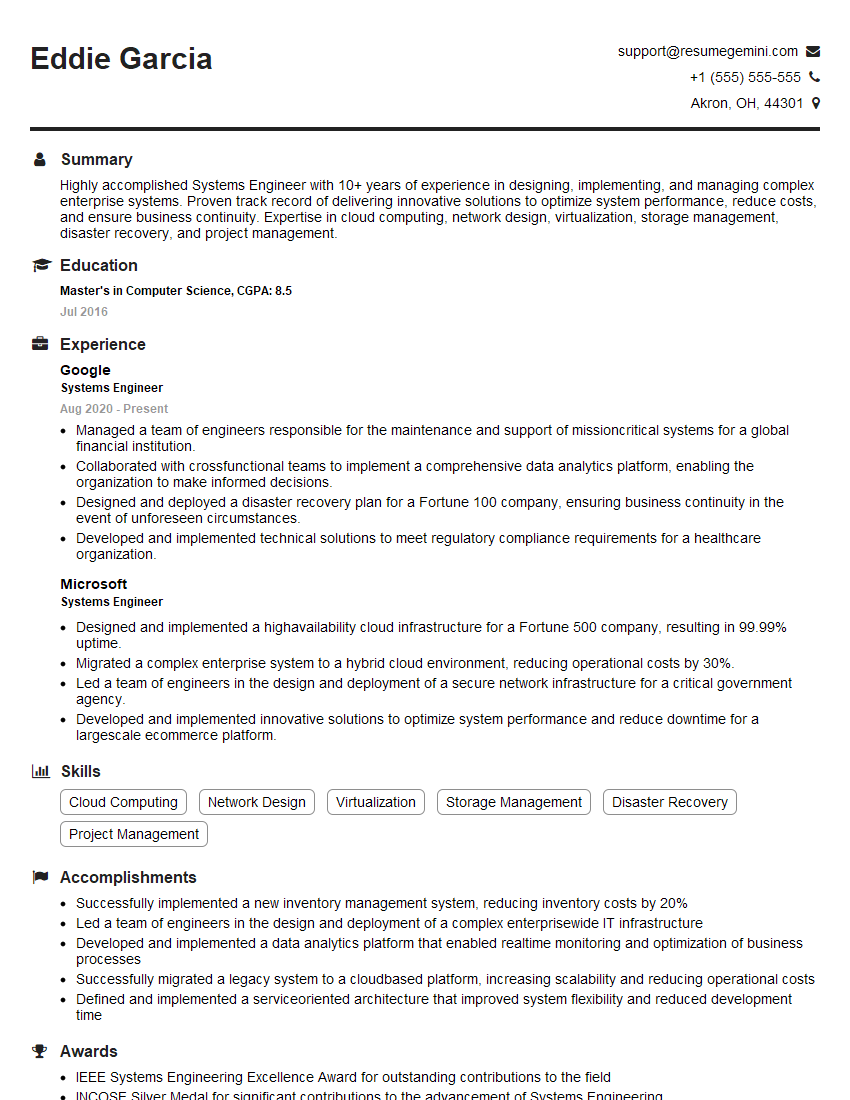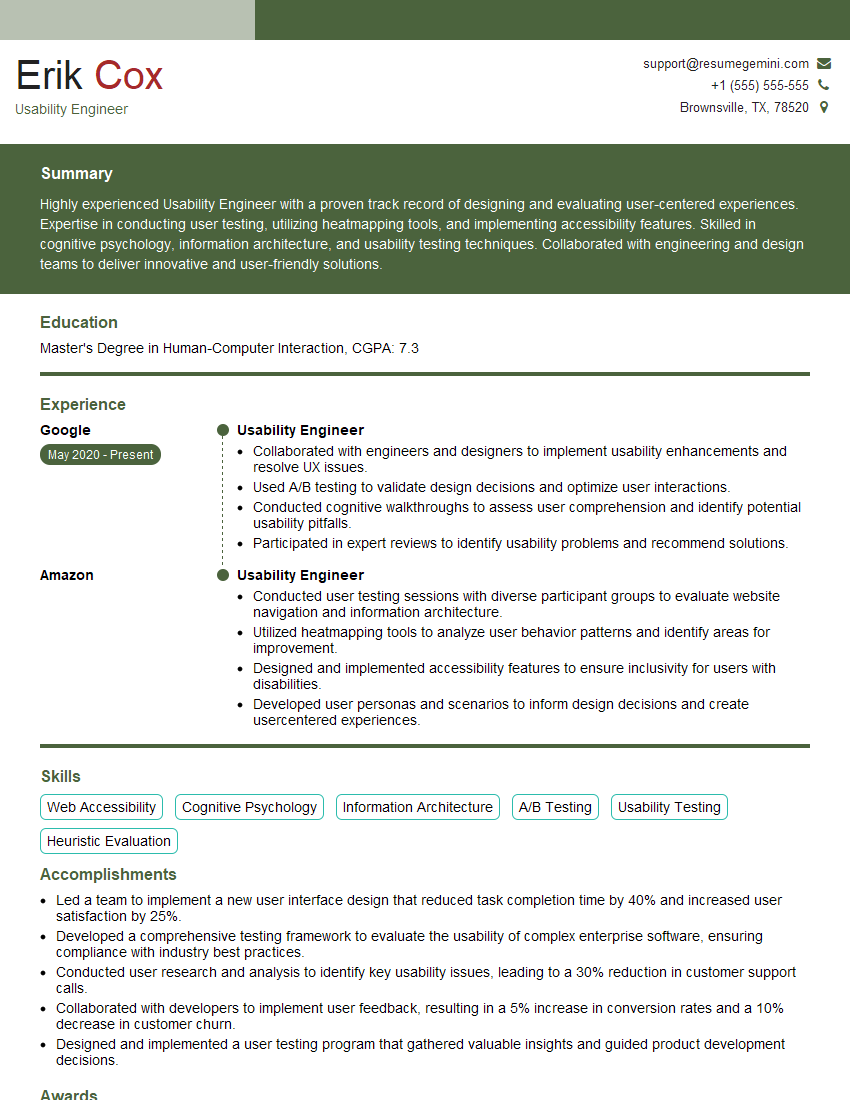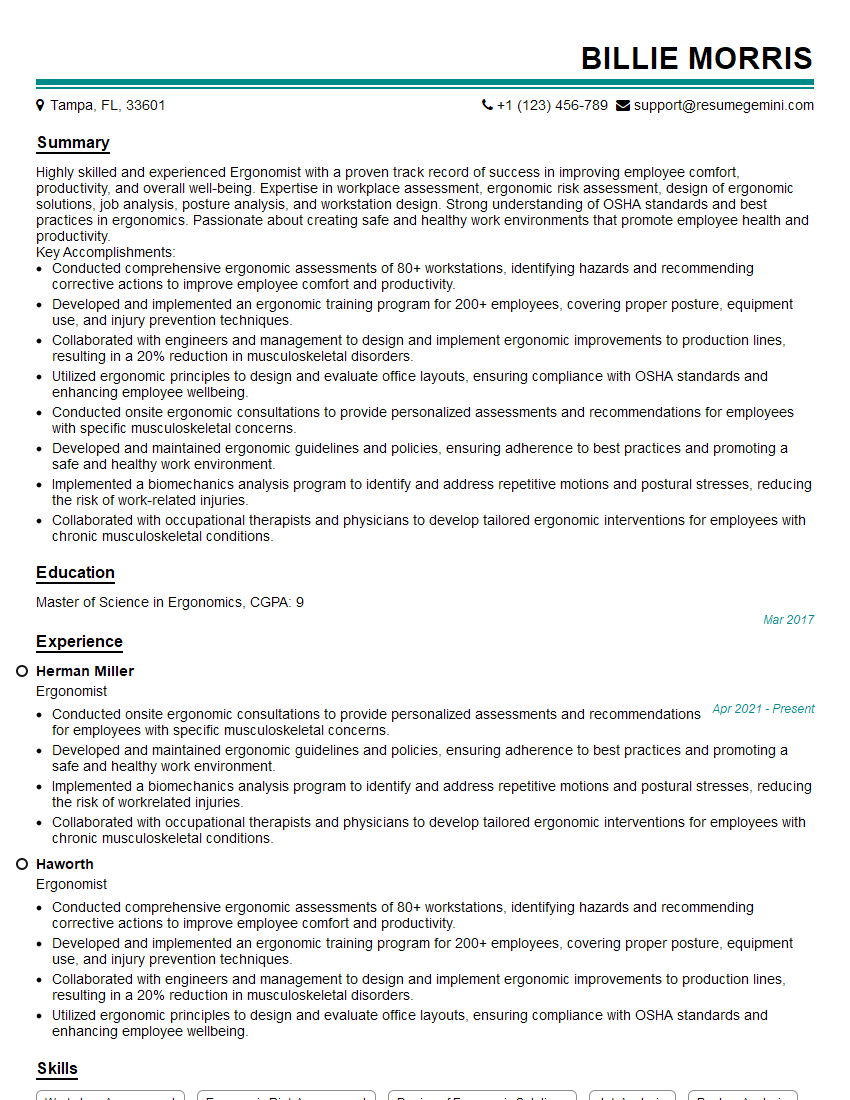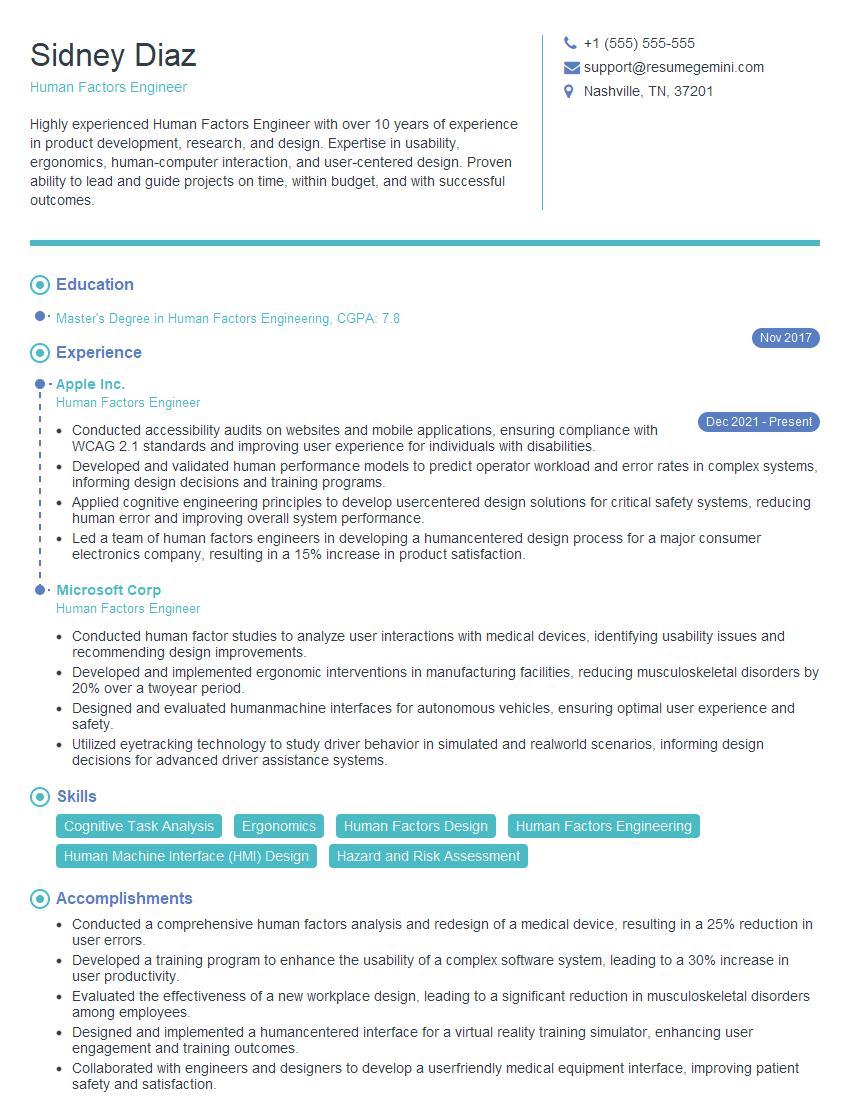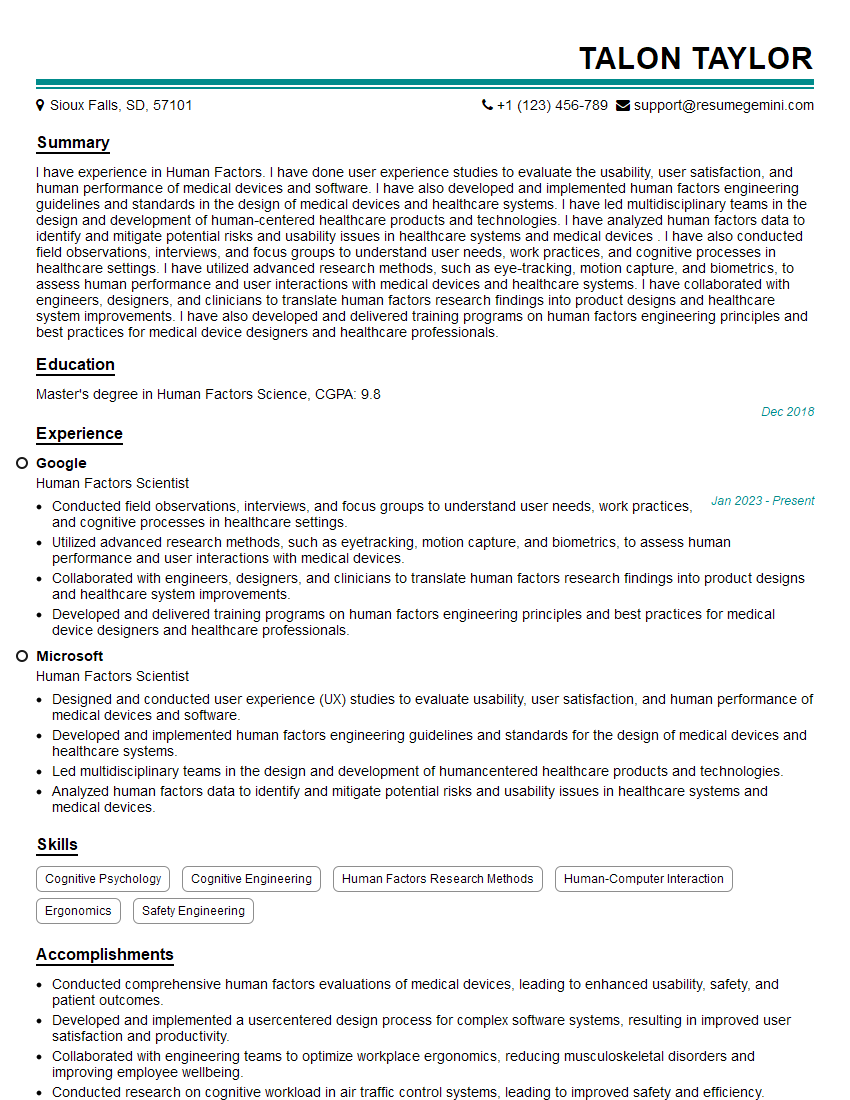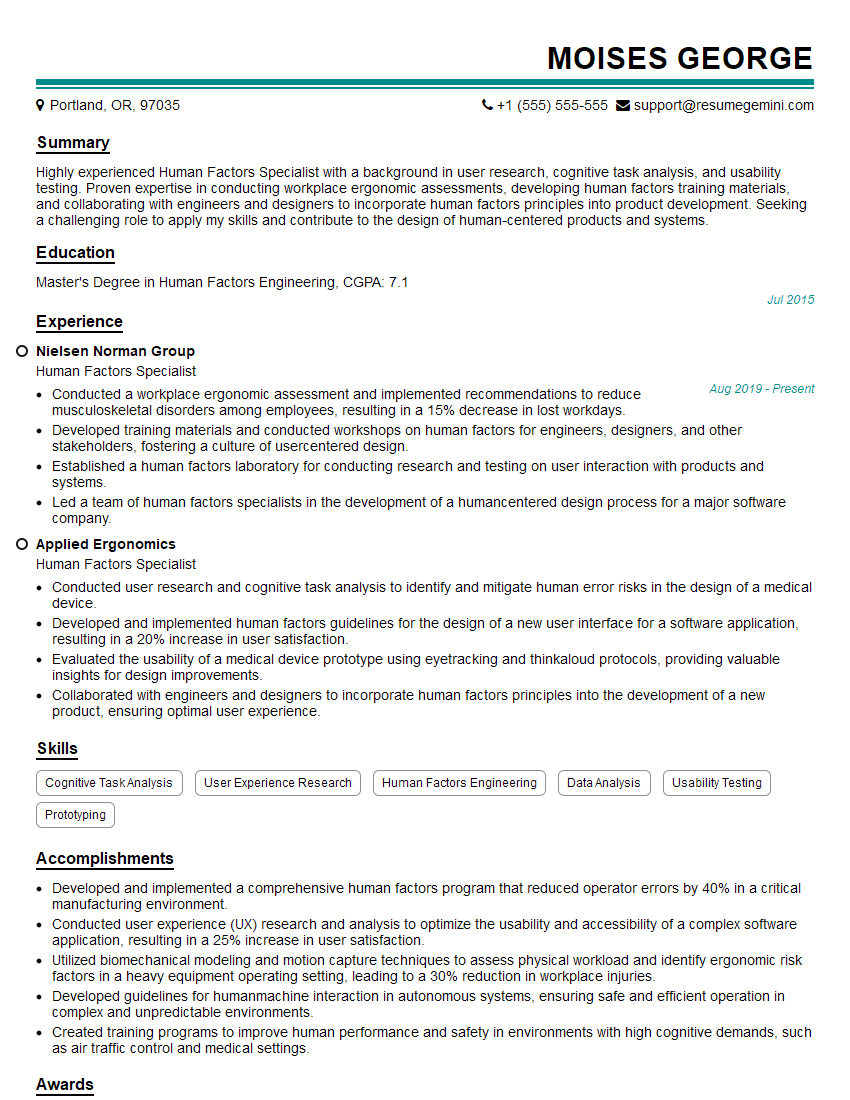Are you ready to stand out in your next interview? Understanding and preparing for Experience in using human factors simulation tools interview questions is a game-changer. In this blog, we’ve compiled key questions and expert advice to help you showcase your skills with confidence and precision. Let’s get started on your journey to acing the interview.
Questions Asked in Experience in using human factors simulation tools Interview
Q 1. What human factors simulation tools are you proficient in?
My proficiency spans a range of human factors simulation tools, encompassing both commercial software and custom-built solutions. I’m highly experienced with software like AnyLogic for agent-based modeling, simulating complex human-system interactions in scenarios like emergency response or crowd behavior. I’ve also extensively used MATLAB/Simulink for creating detailed models of human control performance, often in the context of aviation or automotive applications. Furthermore, I’m skilled in using specialized ergonomics software for virtual reality simulations, enabling realistic assessments of workplace design and usability. Finally, I’m proficient in developing custom simulations using Python and relevant libraries, allowing for tailored solutions to address specific research questions or design problems.
Q 2. Describe your experience validating simulation models.
Validating simulation models is a crucial step to ensure their accuracy and reliability. My approach involves a multi-faceted strategy. First, I conduct face validity checks, reviewing the model structure and parameters with subject matter experts to ensure they align with real-world understanding. Next, I perform predictive validity testing by comparing the simulation outputs to real-world data. For instance, in a study on human-machine interface design, I compared simulated user error rates to actual error rates observed in a user study. Discrepancies lead to model refinement. I also utilize statistical techniques, such as regression analysis, to quantify the goodness of fit between the simulation results and empirical data. Finally, I employ sensitivity analysis to identify critical parameters in the model and assess their impact on the overall outcomes. This iterative process of model refinement ensures a robust and valid simulation.
Q 3. How do you ensure the accuracy and reliability of simulation results?
Ensuring accuracy and reliability hinges on several key factors. Firstly, meticulous data collection and careful parameter selection are paramount. Data should be sourced from credible, peer-reviewed studies or robust empirical experiments. Secondly, appropriate model structure and algorithms are essential. The choice of model type (e.g., discrete event, agent-based) should be aligned with the complexity of the system being simulated. Thirdly, rigorous verification and validation are crucial. This involves meticulously checking the model’s internal consistency and comparing its predictions against real-world data. Finally, comprehensive documentation of all aspects of the simulation process, including data sources, model assumptions, and validation results, is vital for transparency and reproducibility.
Q 4. Explain the process of designing a human factors simulation experiment.
Designing a human factors simulation experiment is an iterative process. It begins with clearly defining the research question or design problem. For example, we might aim to determine the optimal layout of a control panel based on operator performance. Next, a conceptual model is developed, outlining the key elements of the system and their interactions. This is followed by the selection of appropriate simulation tools and the creation of the simulation model itself. Then, experimental design comes into play, deciding on the independent and dependent variables, participants, and experimental conditions. A pilot study is highly beneficial for detecting and correcting any flaws in the experimental design or simulation model before proceeding to full-scale data collection. Finally, the simulation is run, data is analyzed, and findings are interpreted and reported.
Q 5. What are the limitations of using human factors simulation tools?
While human factors simulation tools are powerful, they have limitations. Models are always simplifications of reality and can’t perfectly capture all aspects of human behavior or the complexities of real-world systems. Assumptions and simplifications made in model building can introduce biases, and the model’s predictive validity might be limited to the specific context in which it was developed. Another limitation is computational expense; complex simulations can require significant processing power and time. Finally, the interpretation of simulation results requires careful consideration, and overreliance on simulation results without considering other sources of evidence can be misleading.
Q 6. How do you interpret and present simulation data to stakeholders?
Interpreting and presenting simulation data requires clarity and conciseness. I typically avoid technical jargon when communicating with non-technical stakeholders, instead focusing on conveying the key findings in a way that’s easily understandable. Visualization plays a crucial role; charts, graphs, and interactive dashboards effectively communicate complex data. For instance, I might use a bar chart to compare user error rates under different conditions or an animation to showcase the dynamics of a complex system. Presenting findings in a report with a clear executive summary, methodology section, results section, and conclusions is important for transparency and clear communication. In addition, I often incorporate interactive elements, such as demonstrations of the simulation, to make the findings more engaging and accessible.
Q 7. What are the ethical considerations when using human factors simulation?
Ethical considerations are paramount in human factors simulation. Data privacy must always be respected, ensuring anonymization and secure storage of any data collected. Informed consent should be obtained from any participants involved in the simulation, whether they are directly interacting with the simulation or their data is being used for model calibration. Transparency in the simulation methodology and any limitations of the simulation should be clearly communicated to all stakeholders. Moreover, the use of simulation should always be guided by a commitment to minimizing risks and maximizing benefits, always considering potential consequences and ensuring that the simulations are used responsibly and ethically.
Q 8. Describe your experience with different types of human factors simulations (e.g., discrete event, agent-based).
My experience encompasses a range of human factors simulation tools, primarily focusing on discrete event simulation and agent-based modeling. Discrete event simulation (DES) is excellent for modeling systems with distinct events occurring over time, like analyzing the workflow in a hospital emergency room. I’ve used Arena and Simio extensively for DES, modeling patient flow, resource allocation, and waiting times to optimize processes. Agent-based modeling (ABM), on the other hand, allows me to simulate the interactions of autonomous agents, mimicking human behavior and decision-making. For example, I’ve used NetLogo to model pedestrian movement in a crowded stadium to identify potential bottlenecks and improve safety. In some projects, I’ve even combined these approaches – using DES for the overall system flow and ABM to model the detailed actions of individual operators within that system.
Beyond these, I’ve also worked with human-in-the-loop simulations, where actual human participants interact with a simulated environment, providing valuable real-time data on human performance and decision-making. This approach offers a more realistic representation of the system compared to purely computational models.
Q 9. How do you handle discrepancies between simulation results and real-world data?
Discrepancies between simulation results and real-world data are inevitable, and addressing them is crucial. My approach involves a systematic investigation, starting with a thorough validation of the model itself. This includes checking for coding errors, ensuring the model accurately represents the real-world system’s structure and parameters. If the model is validated, I delve into potential reasons for the discrepancy. This often involves reviewing the assumptions made during model creation and checking for missing or inaccurate data. For instance, a simulation might underestimate wait times if it doesn’t fully account for unexpected events or human variability.
Sometimes, the discrepancy highlights limitations in the model. In such cases, model refinement or even a complete model redesign might be necessary. I might need to incorporate more detailed human behavior models, add more realism to environmental factors, or collect more comprehensive real-world data to improve accuracy. The key is a iterative process of model refinement, data analysis, and comparison, leading to a more robust and reliable simulation.
Q 10. What metrics do you typically use to evaluate the effectiveness of a human-machine system design based on simulation?
The metrics I use depend on the specific goals of the simulation study. However, some common metrics include:
- Throughput: The number of tasks or units processed per unit of time (e.g., patients treated per hour).
- Cycle time: The time taken to complete a task or process.
- Utilization: The percentage of time a resource (e.g., a machine or human operator) is busy.
- Queue length: The average number of items waiting to be processed.
- Error rate: The percentage of tasks completed with errors.
- Task completion time: The time taken to complete specific tasks.
- Workload: The mental and physical demands placed on operators.
- Situation awareness: The operator’s understanding of the system’s state.
For instance, in a factory setting, I might focus on throughput and utilization to optimize production efficiency. In a hospital, I might prioritize metrics related to patient wait times and error rates to ensure high-quality care. The chosen metrics should directly relate to the system’s key performance indicators (KPIs).
Q 11. How do you incorporate human error into your simulation models?
Incorporating human error is vital for creating realistic and useful simulations. I use several techniques, depending on the context and available data. One approach is to use probability distributions to model the likelihood of specific errors. For example, if historical data shows a 5% chance of an operator making a particular mistake, I can use that probability in the simulation. I might use a Poisson or Weibull distribution to model the occurrence of errors over time.
Another approach involves using more sophisticated models of human cognition and decision-making, such as cognitive task analysis, to identify potential error sources and incorporate them into the model. For example, if an operator is likely to make mistakes when they’re fatigued, I can model fatigue levels and incorporate their impact on performance. Some simulation tools offer built-in modules or libraries for modeling human behavior and error more realistically. For complex scenarios, I might consult with human factors experts to ensure a realistic representation of error patterns.
Q 12. Describe your experience with model verification and validation.
Model verification and validation (V&V) are crucial steps in ensuring the simulation’s credibility. Verification focuses on whether the simulation model is correctly implemented – does the code accurately represent the intended design? This involves code reviews, unit testing, and comparison with analytical solutions where possible. Validation, on the other hand, focuses on whether the model accurately represents the real-world system. This typically involves comparing simulation outputs with real-world data, using statistical methods to assess the level of agreement.
Techniques like sensitivity analysis can help identify parameters that significantly influence the model’s output, allowing for a focus on those aspects during validation. Documentation is critical throughout the V&V process to maintain transparency and traceability. Without rigorous V&V, the results of the simulation cannot be trusted.
Q 13. How do you select the appropriate simulation tool for a specific project?
Selecting the right simulation tool depends on several factors: the complexity of the system, the available data, the project budget, and the expertise of the team. For simple systems, a spreadsheet-based simulation might suffice. For more complex systems, dedicated simulation software like Arena, Simio, AnyLogic (for agent-based modeling), or specialized tools for specific domains (e.g., traffic flow simulation) are necessary.
I consider factors like the tool’s capabilities (DES, ABM, human-in-the-loop capabilities), ease of use, availability of training resources, and its compatibility with existing data formats. The tool should be powerful enough to capture the relevant aspects of the system but not so complex that it becomes unwieldy or requires excessive training. Cost and availability of licenses are also important considerations.
Q 14. Explain your understanding of different simulation methodologies (e.g., Monte Carlo, discrete event).
Discrete event simulation (DES) models systems as a sequence of discrete events occurring at specific points in time. It’s ideal for situations where events are distinct and the time between them is significant, such as customer service calls or manufacturing processes. Imagine modeling a bank – events like a customer arriving, being served, and leaving are discrete, and we can track the system’s state at each event. I often use DES software to optimize queuing systems or production lines.
Monte Carlo simulation uses random sampling to model uncertainty and variability. It’s particularly useful when dealing with systems with probabilistic elements, such as financial modeling or weather forecasting. For example, to assess the risk of a project exceeding its budget, we could run multiple simulations with different random inputs (e.g., material costs, labor costs) to generate a probability distribution of potential project costs. The result helps in making informed decisions about risk mitigation.
Q 15. How do you manage the complexity of large-scale human factors simulations?
Managing the complexity of large-scale human factors simulations requires a systematic approach. Think of it like building a skyscraper – you wouldn’t just start laying bricks! We need a well-defined architecture and modular design. This involves breaking down the overall simulation into smaller, manageable modules, each representing a specific aspect of the system or human-machine interaction. For example, in simulating an air traffic control system, we might have separate modules for pilot behavior, air traffic controller workload, weather effects, and communication systems.
Furthermore, effective use of model abstraction and hierarchical modeling are crucial. Abstraction simplifies complex processes into their essential elements, while hierarchical modeling allows us to represent the system at different levels of detail, zooming in or out as needed. This allows for efficient simulations, focusing computation on areas of critical interest. For instance, we can model pilot response time with simplified models in early stages, then refine it with higher fidelity models later. Finally, effective use of simulation software with features like parallel processing and distributed computing is crucial for handling the computational burden of large-scale simulations.
- Modular Design: Breaking down the system into smaller, interconnected modules.
- Model Abstraction: Simplifying complex processes into their essential elements.
- Hierarchical Modeling: Representing the system at different levels of detail.
- Parallel Processing: Using multiple processors to speed up simulations.
Career Expert Tips:
- Ace those interviews! Prepare effectively by reviewing the Top 50 Most Common Interview Questions on ResumeGemini.
- Navigate your job search with confidence! Explore a wide range of Career Tips on ResumeGemini. Learn about common challenges and recommendations to overcome them.
- Craft the perfect resume! Master the Art of Resume Writing with ResumeGemini’s guide. Showcase your unique qualifications and achievements effectively.
- Don’t miss out on holiday savings! Build your dream resume with ResumeGemini’s ATS optimized templates.
Q 16. What is your experience with data analysis and visualization techniques related to simulation data?
My experience with data analysis and visualization is extensive. I’m proficient in statistical software packages like R and Python (using libraries like Pandas, NumPy, and SciPy) and visualization tools such as Tableau and Power BI. Analyzing simulation data often involves dealing with large datasets, so efficient data wrangling and manipulation are essential. I regularly employ techniques like descriptive statistics (mean, median, standard deviation), inferential statistics (t-tests, ANOVA), and regression analysis to understand relationships between variables. For example, in a driving simulation, we might analyze reaction time data to determine the effect of different interface designs on driver performance.
Visualization is key to communicating findings effectively. I use various chart types, including histograms, scatter plots, box plots, and heatmaps, to present data in a clear and understandable manner. Interactive dashboards, built using tools like Tableau, allow stakeholders to explore the data themselves and identify trends or patterns. For example, a heatmap could visually show areas of high driver workload during a simulated emergency situation. Finally, appropriate statistical tests ensure robustness of findings.
# Example R code for calculating mean reaction time: mean(reaction_time_data)Q 17. Describe a time you had to troubleshoot a problem with a human factors simulation tool.
During a simulation of a complex industrial control system, we encountered a significant issue where the simulation would unexpectedly crash after a specific sequence of user actions. It was initially frustrating because the error messages were vague. Our troubleshooting involved a systematic approach:
- Reproducing the error: We meticulously documented the exact steps leading to the crash, ensuring consistent replication.
- Log analysis: We examined the simulation’s detailed logs, looking for patterns or clues in the error messages and timestamps.
- Debugging: Using the software’s debugging tools, we stepped through the code execution to identify the precise location of the crash.
- Code review: We scrutinized the relevant code sections, identifying a concurrency issue where two threads were accessing and modifying the same data simultaneously, leading to data corruption and the eventual crash.
- Solution Implementation: We implemented a mutex lock to synchronize access to the shared data, resolving the concurrency problem and preventing the crashes.
This experience highlighted the importance of thorough logging, systematic debugging, and a deep understanding of the underlying software architecture for effective troubleshooting.
Q 18. How do you ensure the usability of your simulation interfaces?
Ensuring usability is paramount. I apply human factors principles throughout the interface design process. This includes adhering to established usability heuristics, such as those from Nielsen’s 10 Usability Heuristics for User Interface Design. Key aspects include:
- Intuitive navigation: The simulation interface should be easy to learn and use, with clear and consistent labeling and visual cues.
- Efficient task completion: Users should be able to accomplish their tasks quickly and efficiently with minimal errors.
- Error prevention: The interface should minimize the potential for user errors through clear instructions, helpful feedback, and error prevention mechanisms.
- Accessibility: The interface should be accessible to users with disabilities, adhering to accessibility guidelines (e.g., WCAG).
- Iterative testing: I always include usability testing throughout the design process to gather feedback from real users and iteratively refine the interface.
For example, during the design of a flight simulator, we conducted user testing with pilots to ensure that the controls and displays were intuitive and that essential information was easily accessible in critical scenarios.
Q 19. What is your experience with human factors standards and guidelines related to simulation?
My experience encompasses a wide range of human factors standards and guidelines relevant to simulation, including ISO 9241 (Ergonomics of human-system interaction), IEEE standards for software engineering, and aviation-specific standards like those published by the FAA and EASA. These standards provide frameworks for usability, safety, and human performance in interactive systems. I use these standards as a foundation for designing, evaluating, and validating simulations.
For example, when developing a driving simulator, we ensure compliance with relevant standards for visual fidelity, control responsiveness, and safety features, taking into account driver fatigue and attention limitations. Staying current with these standards ensures that our simulations are not only effective but also meet the required safety and regulatory requirements. I also consider relevant guidelines for scenario design, data collection, and analysis methods, ensuring the reliability and validity of results.
Q 20. How do you integrate human factors simulation results into the overall design process?
Integrating human factors simulation results effectively is crucial for successful design. It’s not enough to just run a simulation; the findings need to be thoughtfully integrated into the design process. This usually involves a multi-step process:
- Clear objectives: Defining clear objectives for the simulation upfront is vital to guide the analysis and interpretation of results.
- Data analysis and interpretation: Thorough data analysis to extract relevant insights, using appropriate statistical methods.
- Feedback loops: Regularly incorporating feedback from simulations into the design process, iteratively refining the design based on what the simulations reveal.
- Communication and visualization: Communicating the findings to stakeholders clearly and effectively through reports, presentations, and visualizations.
- Decision support: Providing quantitative data that supports design decisions, influencing system design choices.
For instance, if a simulation reveals that a specific control layout in a factory leads to high error rates, this information directly influences the redesign of that control system in the actual factory environment.
Q 21. Describe your experience with different types of human-computer interfaces (HCIs) within simulations.
My experience with different HCIs within simulations is broad. I’ve worked with a range of interfaces, from simple command-line interfaces to complex 3D virtual environments with immersive head-mounted displays.
Simple interfaces: These are effective for specific tasks or initial prototyping, but might lack the richness and fidelity needed for more complex interactions. Graphical User Interfaces (GUIs): I have extensive experience using GUIs in simulations, utilizing various widget types (buttons, sliders, menus) to create intuitive user interactions. Virtual Reality (VR): VR simulations provide highly immersive experiences, particularly beneficial for training scenarios and realistic environment modeling. I’ve used VR systems to develop training applications for various industries. Augmented Reality (AR): AR overlays digital information onto the real world, creating interactive environments that blend the physical and virtual. In some simulations, AR can be effective for providing real-time feedback or guidance. Voice interfaces: Voice-controlled simulations offer hands-free control, especially useful when a user’s hands are occupied. However, the robustness of voice recognition can influence the success of such interfaces. Each interface type presents unique challenges and opportunities, and the choice depends heavily on the specific application and its requirements. The selection process necessitates a thorough understanding of user needs and limitations.
Q 22. How do you assess the impact of environmental factors on human performance within a simulation?
Assessing the impact of environmental factors on human performance in simulation involves systematically incorporating relevant environmental variables into the model. This isn’t just about adding visual elements; it’s about understanding how these factors influence cognitive processes, physical capabilities, and overall task performance.
For example, we might simulate the effects of high ambient temperature on a factory worker’s reaction time using a model that incorporates physiological responses to heat stress. This could involve adjusting parameters within the simulation to reflect reduced dexterity, increased fatigue, or slower cognitive processing speed at higher temperatures. Similarly, simulating a driving task in heavy rain would require incorporating reduced visibility, slippery road conditions, and potentially, increased driver stress levels within the model.
This often requires multi-disciplinary collaboration, pulling in expertise from fields like meteorology, ergonomics, and physiology to accurately represent these effects. The key is not just simulating the environment visually, but modeling its physiological and psychological impacts on the human operator.
Q 23. What are the key differences between different types of human factors simulation software?
Human factors simulation software varies considerably based on its purpose and fidelity. Broadly, we can categorize them into several types:
- Task-oriented simulators: These focus on specific tasks, often using simplified models of the human and environment. Think of simple button-pressing experiments using software like E-Prime or PsychoPy. They are great for quick experiments and evaluating specific interfaces.
- Human-in-the-loop (HITL) simulators: These involve a human operator directly interacting with a simulated system, such as a flight simulator or a driving simulator. These provide a more realistic representation of human interaction with complex systems. These require sophisticated rendering and physics engines.
- Agent-based models: These model the behavior of multiple individuals (agents) within a simulated environment. They’re commonly used in crowd simulation or emergency response scenarios, modeling how people behave collectively in response to environmental factors. These require strong computational power.
- Physiological models: These simulate human physiology in detail, often used in studies of fatigue, workload, or heat stress. These require a deep understanding of biomechanics and physiology.
The key differences lie in their complexity, fidelity (how closely they represent reality), the level of human interaction, and the specific human factors they are designed to address. The choice depends entirely on the research question.
Q 24. How do you handle uncertainty and variability in human factors simulations?
Uncertainty and variability are inherent in human factors simulations because human behavior is inherently unpredictable. We address this through a combination of techniques:
- Probabilistic modeling: Instead of using fixed values for parameters like reaction time or error rate, we use probability distributions. This allows the simulation to generate a range of possible outcomes, reflecting the inherent variability in human behavior.
- Monte Carlo simulations: This involves running the simulation many times with different random inputs, providing a statistical distribution of results. This helps understand the range of potential outcomes and their likelihood.
- Sensitivity analysis: This involves systematically varying input parameters to determine how sensitive the simulation results are to changes in those parameters. This helps identify which parameters most significantly impact the outcomes and where further refinement of data might be most helpful.
- Human-in-the-loop experiments: This allows for validation of simulation results against real-world human behavior. By incorporating real human responses into the model, we can adjust parameters accordingly and reduce bias in the simulation results.
The goal is not to eliminate uncertainty, but to understand and quantify it, providing a more realistic and nuanced understanding of human performance.
Q 25. Explain your experience in using simulation to support decision-making in design processes.
I’ve extensively used simulation to support design decisions, particularly in the design of human-computer interfaces (HCIs) and control systems. For instance, in one project involving the design of a new aircraft cockpit, we used a high-fidelity flight simulator to test various interface designs. The simulation allowed pilots to interact with different layouts, testing their usability and effectiveness in various simulated flight scenarios (take-off, landing, emergency situations).
The simulation provided critical data on task completion times, error rates, and pilot workload, leading to significant improvements in the final design. Specifically, we identified a design flaw in the original layout that led to excessive pilot workload during critical phases of flight. Through iterative simulations with design modifications we were able to rectify this issue, making it easier and safer for the pilot to control the aircraft.
In another instance, we used agent-based modeling to simulate pedestrian flow in a new airport terminal. The simulation helped identify potential bottlenecks and areas requiring design modifications to improve pedestrian traffic and safety. This prevented major design flaws which would have been otherwise difficult to identify until the design was physically constructed.
Q 26. Describe your approach to validating and verifying human factors simulation models using real-world data.
Validating and verifying human factors simulation models is crucial. Verification focuses on ensuring the simulation accurately represents the intended model; validation ensures the model accurately represents the real-world system. My approach involves:
- Data collection: I gather relevant real-world data on human performance, through experiments, observations, or existing datasets. This data might include task completion times, error rates, physiological measures (heart rate, eye movements), or subjective workload ratings.
- Model comparison: I compare the simulation’s output to the real-world data. This often involves statistical analysis to assess the degree of agreement. Discrepancies necessitate adjustments to the model’s parameters or structure.
- Iterative refinement: Based on the comparison, I iteratively refine the simulation model until a satisfactory level of agreement between simulated and real-world data is achieved.
- Expert review: I involve other human factors experts in the validation process, ensuring that the model’s assumptions and limitations are clearly understood and addressed.
For example, if simulating a manufacturing task, I’d validate the model by comparing simulated assembly times and error rates to those observed in a real factory setting. This iterative process ensures the simulation’s accuracy and reliability.
Q 27. How do you communicate technical simulation results to non-technical audiences?
Communicating complex simulation results to non-technical audiences requires a clear, concise, and visual approach. I avoid jargon and technical details whenever possible, focusing instead on conveying the key findings in a readily understandable format. This often involves:
- Visual aids: Graphs, charts, and videos are powerful tools for presenting complex data in a digestible way. A simple bar chart comparing task completion times across different design options is far more effective than a table of statistical data.
- Storytelling: Framing the results within a narrative helps to make the information relatable and memorable. Instead of just presenting numbers, I explain the implications of the findings in a way that connects with the audience’s concerns and interests.
- Analogies and metaphors: Using relatable analogies helps non-technical audiences understand abstract concepts. For example, I might compare the complexity of a system to a simple machine.
- Interactive presentations: Interactive elements, such as demonstrations or simulations, can help to engage the audience and make the information more memorable.
The key is to tailor the communication strategy to the specific audience and their level of technical understanding.
Q 28. How do you stay up-to-date on the latest advances in human factors simulation tools and techniques?
Staying current in the rapidly evolving field of human factors simulation requires a multi-pronged approach:
- Professional organizations: Active participation in organizations like the Human Factors and Ergonomics Society (HFES) provides access to conferences, publications, and networking opportunities.
- Journals and publications: Regularly reading relevant journals and publications keeps me abreast of the latest research and advancements in simulation techniques and tools. I look for peer-reviewed articles to ensure the quality of the information.
- Conferences and workshops: Attending conferences and workshops allows me to learn from experts in the field, explore new technologies, and network with colleagues.
- Online resources: I utilize online resources such as databases and professional websites to access the latest research and publications.
- Continuing education: I actively pursue continuing education opportunities, such as workshops and online courses, to enhance my knowledge and skills.
Continuous learning is essential to maintain my expertise and effectively utilize the latest simulation tools and techniques.
Key Topics to Learn for Experience in using Human Factors Simulation Tools Interview
- Understanding Simulation Types: Familiarize yourself with different human factors simulation tools and their applications (e.g., driving simulators, flight simulators, virtual reality environments for usability testing, process simulation for workflow analysis). Understand the strengths and limitations of each type.
- Data Collection and Analysis: Master techniques for collecting and analyzing data from simulations. This includes understanding different data types (e.g., physiological data, behavioral data, subjective ratings), appropriate statistical methods, and the interpretation of results to draw meaningful conclusions about human performance and system design.
- Experimental Design: Learn the principles of designing effective simulation-based experiments. This includes understanding factors like sample size, control groups, independent and dependent variables, and choosing appropriate experimental methodologies (e.g., within-subjects vs. between-subjects designs).
- Human-Computer Interaction (HCI) Principles: Demonstrate a strong understanding of HCI principles and how they apply to the design and evaluation of simulated systems. Be prepared to discuss usability heuristics, user-centered design processes, and techniques for identifying and mitigating usability issues revealed through simulation.
- Modeling Human Behavior: Understand the various models and techniques used to represent human behavior in simulations (e.g., cognitive models, biomechanical models). Be able to discuss their strengths, limitations, and appropriate applications.
- Software Proficiency: Showcase your practical experience with specific human factors simulation software packages (mentioning those relevant to your experience). Be ready to discuss your workflow, data management, and problem-solving skills within these platforms.
- Interpreting Results and Recommendations: Practice translating simulation data into actionable recommendations for improving system design, enhancing safety, and optimizing human performance. Be prepared to discuss how you’ve used simulation results to inform real-world design decisions.
Next Steps
Mastering experience in using human factors simulation tools significantly enhances your career prospects in fields requiring user-centered design, safety analysis, and human performance optimization. An ATS-friendly resume is crucial for getting your application noticed. To maximize your chances, leverage ResumeGemini to build a professional resume that highlights your skills and experience effectively. ResumeGemini provides examples of resumes tailored to Experience in using human factors simulation tools, helping you create a compelling application that stands out.
Explore more articles
Users Rating of Our Blogs
Share Your Experience
We value your feedback! Please rate our content and share your thoughts (optional).
What Readers Say About Our Blog
Hello,
We found issues with your domain’s email setup that may be sending your messages to spam or blocking them completely. InboxShield Mini shows you how to fix it in minutes — no tech skills required.
Scan your domain now for details: https://inboxshield-mini.com/
— Adam @ InboxShield Mini
Reply STOP to unsubscribe
Hi, are you owner of interviewgemini.com? What if I told you I could help you find extra time in your schedule, reconnect with leads you didn’t even realize you missed, and bring in more “I want to work with you” conversations, without increasing your ad spend or hiring a full-time employee?
All with a flexible, budget-friendly service that could easily pay for itself. Sounds good?
Would it be nice to jump on a quick 10-minute call so I can show you exactly how we make this work?
Best,
Hapei
Marketing Director
Hey, I know you’re the owner of interviewgemini.com. I’ll be quick.
Fundraising for your business is tough and time-consuming. We make it easier by guaranteeing two private investor meetings each month, for six months. No demos, no pitch events – just direct introductions to active investors matched to your startup.
If youR17;re raising, this could help you build real momentum. Want me to send more info?
Hi, I represent an SEO company that specialises in getting you AI citations and higher rankings on Google. I’d like to offer you a 100% free SEO audit for your website. Would you be interested?
Hi, I represent an SEO company that specialises in getting you AI citations and higher rankings on Google. I’d like to offer you a 100% free SEO audit for your website. Would you be interested?
good
